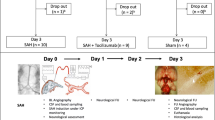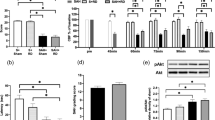Abstract
Retrograde cerebral perfusion (RCP) has recently been reported to be useful for the repair of aortic arch aneurysms. However, there is a possibility that RCP supplies a limited amount of blood to the brain [1] and ischemia-reperfusion injury may occur after RCP. FR167653 (FR) is characterized as a potent suppressant of interleukin-1β and tumor necrosis factor-α. We investigated the role of FR in preventing cerebral ischemia-reperfusion injury after RCP in a canine model. A total of 12 mongrel dogs was divided into two groups: in the FR group (n=6), FR167653 (1 mg/kg/hour) was continuously administered during the period of RCP and rewarming; in the control group (n=6), a physiological saline solution was administered at the same dosage as the FR167653 during the same period. Following hypothermia (20°C) using cardiopulmonary bypass and circulatory arrest, RCP was performed by infusing oxygenated blood via the bilateral internal maxillary veins for 60 minutes at a perfusion pressure of 25 mmHg. The cerebral blood flow (CBF), cerebral metabolic rate for glucose (CMRGlu) and oxygen (CMRO2), and excretion of carbon dioxide (ExCO2) were measured. These results were expressed as the percentage of change from baseline values established immediately after anesthesia. CBF was significantly (p<0.05) higher in the FR group than in the control group at 40 (159±25% and 82±21%, respectively) and 60 minutes (177±30% and 83±14%, respectively) after RCP. The lactate/pyruvate ratio of blood returned from the brain tissues was significantly (p<0.05) lower in the FR group than in the control group at 40 and 60 minutes after RCP. CMRGlu was significantly (p<0.05) higher in the FR group than in the control group 60 minutes after RCP. There was no significant difference in CMRO2 and ExCO2 between the two groups. It is concluded that FR167653 appears to be effective in protecting the brain from ischemia-reperfusion injury after RCP.
Similar content being viewed by others
References
Ye J, Yang L, Del Bigio MR, Summers R, Jackson D, Somorjai RL, Salerno TA, Deslauriers R (1997) Retrograde cerebral perfusion provides limited distribution of blood to the brain: A study in pigs. J Thorac Cardiovasc Surg 114:660–665.
Kamoshita N, Takeyoshi I, Ohwada S, Iino Y, Morishita Y (1997) The effect of FR167653 on pulmonary ischemia-reperfusion injury in dogs. J Heart Lung Transplant 16:1062–1072.
Yamamoto N, Sakai F, Yamazaki H, Nakahara K, Okuhara M (1996) Effect of FR167653, a cytokine suppressive agent, on endotoxininduced disseminated intravascular coagulation. Eur J Pharmacol 314:137–142.
Sato Y, Hasegawa Y, Takahashi T, Ishikawa S, Morishita Y (1997) Optimal brain temperature for retrograde cerebral perfusion in dogs. Int J Angiol 7:632–637.
Usui A, Oohara K, Liu T, Murase M, Tanaka M, Takeuchi E, Abe T (1994) Determination of optimum retrograde cerebral perfusion conditions. J Thorac Cardiovasc Surg 107:300–308.
Usui A, Hotta T, Hiroura M, Murase M, Maeda M, Koyama T, Tanaka M, Takeuchi E, Yasuura K, Watanabe T, Abe T (1992) Retrograde cerebral perfusion through a superior vena caval cannula protects the brain. Ann Thorac Surg 53:47–53.
Miller MM (1964) The venous system. In: Anatomy of the Dog, Miller MM (ed). WB Saunders: Philadelphia, pp 389–435.
Ueda Y, Miki S, Okita Y, Tahata T, Ogino H, Sakai T, Morioka K, Matsuyama K (1994) Protective effect of continuous retrograde cerebral perfusion on the brain during deep hypothermic systemic circulatory arrest. J Cardiovasc Surg (Torino) 9:584–595.
Seekamp A, Warren JS, Remick DG, Till GO, Ward PA (1993) Requirements for tumor necrosis factor-α and interleukin-1 in limb ischemia/reperfusion injury and associated lung injury. Am J Pathol 143:453–463.
Serrick C, Adoumie R, Giaid A, Shennib H (1994) The early release of interleukin-2, tumor necrosis factor-α and interleukin-γ after ischemia reperfusion injury in the lung allograft. Transplantation 58:1158–1162.
Palace GP, Del Vecchio PJ, Horgan MJ, Malik AB (1993) Release of tumor necrosis factor after pulmonary artery occlusion and reperfusion. Am Rev Respir Dis 147:143–147.
Larrick JW, Graham D, Toy K, Lin LS, Senyk G, Fendly BM (1987) Recombinant tumor necrosis factor causes activation of human granulocytes. Blood 69:640–644.
Shalaby MR, Aggarwal BB, Rinderknecht E, Svedersky LP, Finkle BS, Palladino MA Jr (1985) Activation of human polymorphonuclear neutrophil functions by interferon-γ and tumor necrosis factors. J Immunol 135:2069–2073.
Shalaby MR, Palladino MA Jr, Hirabayashi SE, Essalu TE, Shepard HM, Aggarwal BB (1987) Receptor binding and activation of polymorphonuclear neutrophils by tumor necrosis factor-alpha. J Leuk Biol 41:196–204.
Zamora CA, Baron DA, Heffner JE (1993) Thromboxane contributes to pulmonary hypertention in ischemia-reperfusion lung injury. J Appl Physiol 74:224–229.
Okusawa S, Gelfand JA, Ikejima T, Connolly RJ, Dinarello CA (1988) Interleukin 1 induces a shock-like state in rabbits: Synergism with tumor necrosis factor and the effect of cyclooxygenase inhibition. J Clin Invest 81:1162–1172.
Canadian Cooperative Study Group (1978) Randomized trial of aspirin and sulfin pyrazone in threatened stroke. N Engl J Med 299:53–59.
Fisher M, Zipser R (1985) Increased excretion of immunoreactive thromboxane B2 in cerebral ischemia. Stroke 16:10–14.
Koudstaal PJ, Ciabattoni G, van Gijin J, Nieuwenhuis HK, de Groot PG, Sixma JJ, Patrono C (1993) Increased thromboxane biosynthesis in patients with acute cerebral ischemia. Stroke 24:219–223.
Johnson J, Brigham KL, Jesmok G, Meyrick B (1991) Morphologic changes in lungs of anesthetized sheep following intravenous infusion of recombinant tumor necrosis factor-α. Am Rev Respir Dis 144:179–186.
McCord JM (1985) Oxygen-derived free radicals in postischemic tissue injury. N Engl J Med 312:159–163.
Shapiro HM (1985) Post-cardiac arrest therapy: Calcium entry blockade and brain resuscitation. Anesthesiology 62:384–387.
Steen PA, Newberg LA, Milde JH, Michenfelder JD (1984) Cerebral blood flow and neurologic outcome when nimodipine is given after complete cerebral ischemia in the dog. J Cereb Blood Flow Metab 4:82–87.
Yoshimura N, Okada M, Ota T, Nohara H (1995) Pharmacologic intervention for ischemic brain edema after retrograde cerebral perfusion. J Thorac Cardiovasc Surg 109:1173–1181.
Nojima T, Magara T, Nakajima Y, Waterida S, Onoe M, Sugita T, Mori A (1994) Optimal perfusion pressure for experimental retrograde cerebral perfusion. J Cardiovasc Surg (Torino) 9:548–559.
Author information
Authors and Affiliations
About this article
Cite this article
Oshima, K., Sato, Y., Takeyoshi, I. et al. The effect of FR167653 on cerebral ischemia-reperfusion injury after retrograde cerebral perfusion in a canine model. International Journal of Angiology 8, 143–146 (1999). https://doi.org/10.1007/BF01616441
Issue Date:
DOI: https://doi.org/10.1007/BF01616441




